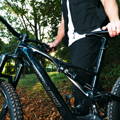All about electric bikes
Electric bikes, commonly referred to as e-bikes, operate similarly to traditional bicycles but with a crucial enhancement: they combine human power with the assistance of a silent electric motor. This motor significantly reduces the effort needed to pedal, making it easier to gain speed and tackle various terrains. However, it’s important to note that an electric bike amplifies your pedaling power—it doesn’t replace it. So, if you're imagining an e-bike that rides on its own, think again!

The Mechanics Behind Electric Bikes
An electric bike motor provides seamless assistance up to speeds of 20 mph, or even 28 mph for speed bikes. This means that climbing steep hills becomes less strenuous, and battling headwinds is much easier. With an electric bike, you can travel farther and faster with less physical fatigue.
Whether you're looking for a greener way to commute or need a boost to conquer steep inclines, an electric bike is an excellent solution. But how exactly does an electric bike work? Can you ride one without motor assistance? Let’s dive into the key components that make an e-bike tick.
How Electric Bike Components Work Together
Bikepacking equipment must be chosen with care. Essentials include bikepacking panniers, a lightweight tent, a sleeping bag, a sleeping pad, bike repair tools, and appropriate clothing. Choosing the right equipment for your needs and budget is crucial to a successful bikepacking experience.
Sensors
The core of an e-bike’s functionality lies in its sensors, primarily the cadence or torque sensors. These sensors detect either the power you’re generating or the speed of your wheels and adjust the motor's assistance accordingly. The harder you pedal, the more assistance you receive from the motor.
Motor Placement
Electric bikes can feature motors in various locations: on the pedals, the front wheel, or the rear wheel.
- Pedal Motors: These motors are highly responsive, adjusting quickly to your pedaling efforts for optimal rotation speed. They are typically more powerful but may put additional strain on the bike's transmission system and brakes.
- Hub Motors: Positioned in the center of either the front or rear wheel, hub motors rely on rotation sensors. They provide a less natural feel of assistance and consume more energy.
Battery Power
- Eco Mode: Offers up to 50% assistance, extending battery life.
- Tour Mode: Delivers 120% of your power, ideal for winding roads.
- Turbo Mode: Provides maximum assistance (up to 300%) at the cost of reduced battery life.
Control screen
Typically located on the handlebars, the control screen allows you to select your preferred level of assistance and provides essential battery information. Some advanced e-bikes offer additional features like GPS navigation, fitness tracking, and trip data export.
Key Components of an Electric Bike
- The Motor: A vital part of the e-bike, motors come in various types, each affecting the bike’s performance differently.
- Front-Wheel Motors: These are simple and cost-effective, working with a speed sensor to offer reliable assistance. However, they can be tricky on slippery surfaces.
- Rear-Wheel Hub Motors: Positioned within the bike’s gears, these motors provide a powerful propulsion feeling, making them suitable for diverse terrains.
- Pedal Motors (Mid-Drive Motors): Located near the pedals, these motors offer stability and maneuverability, making them ideal for long-distance rides.
- Battery: The battery is the powerhouse of your electric bike, determining the overall range and performance. Modern lithium-ion batteries are lightweight and capable of powering your bike for dozens of miles on a single charge.
- Chassis and Transmission: A lightweight frame, usually made of aluminum, enhances the bike's efficiency. The transmission system—comprising the pedals, chainrings, cranks, chains, and sprockets—works in harmony with the motor to deliver smooth power transfer.
- Brakes: Given the higher speeds and extra weight of e-bikes, powerful brakes are essential. Hydraulic disc brakes are highly recommended for their reliability in all weather conditions.
- Controller: The controller acts as the brain of the e-bike, regulating the electrical signals between the motor, battery, and other components to ensure smooth operation.
Types of Electric Assistance Systems
Non-Proportional Assistance
This system, using a rotation sensor, provides continuous power assistance when it detects pedaling. It doesn’t adjust based on the rider’s effort or terrain.
Proportional Assistance:
This system uses a torque sensor to provide assistance based on the rider’s pedaling effort. It offers a smoother and more natural riding experience, often found in higher-end models.


